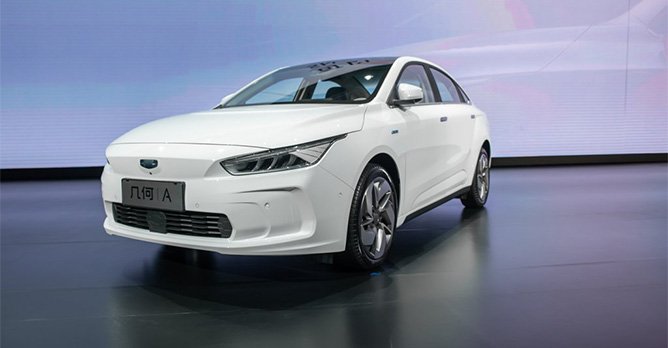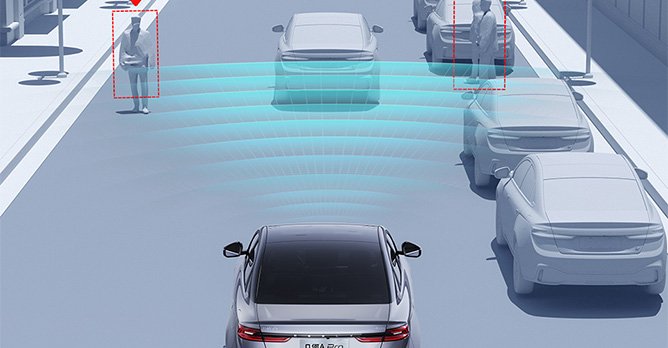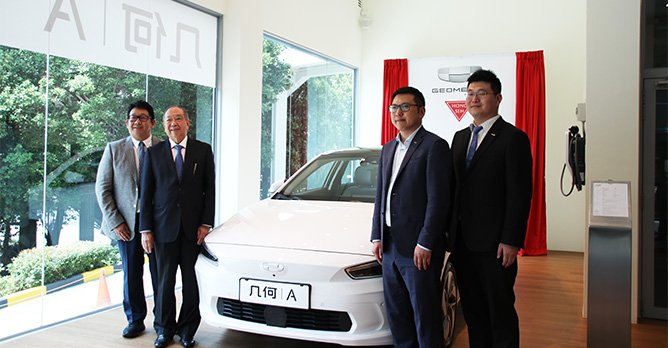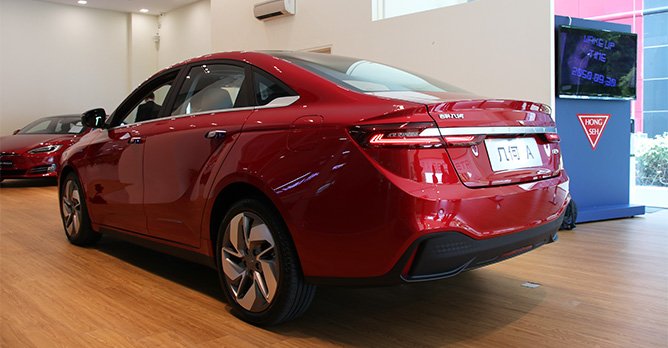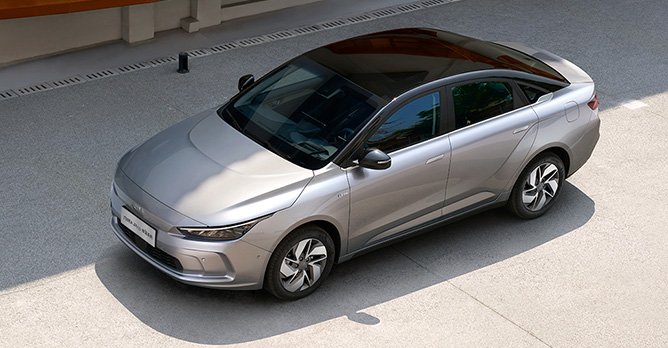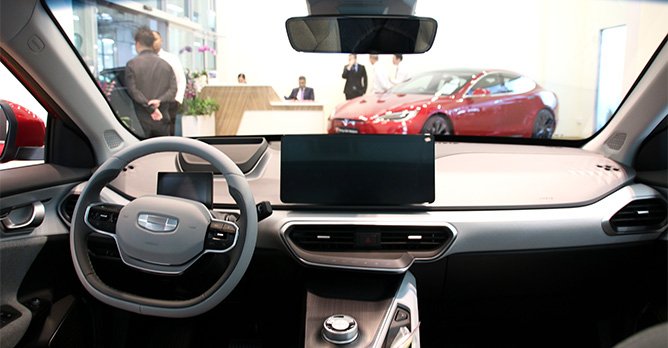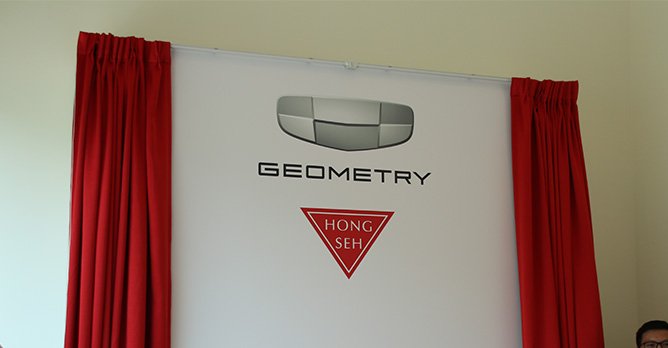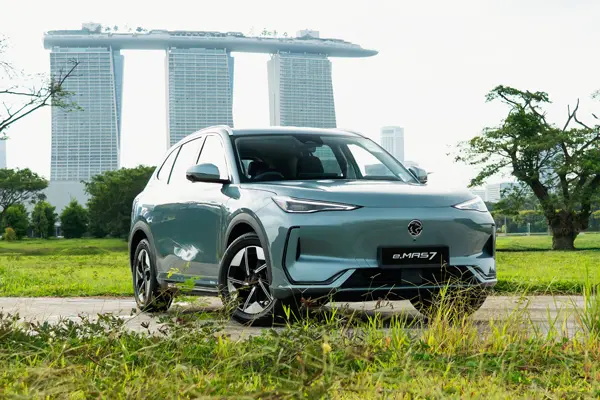Singapore's forgotten EVs, Part 1: The Geometry A
22 Aug 2022|7,404 views
A star-studded, shimmering launch at Marina Bay Sands in April 2019. Financial and technological backing by a multi-national Chinese conglomerate, in charge of some very successful automotive brands. And above all, specifications for an electrical vehicle (EV) that would have made an enticing case for a switchover from ICE cars.
The Geometry A was Geely's first attempt at a mass market EV - even holding the honour of debuting the entire Geometry brand itself. And despite its questionable marketing shtick (the arithmetic language still muddies quick searches/search-engine optimisation, and no, 'A' doesn't represent the brand's first model, but 'Archimedes', as in the Greek mathematician), the car itself was anything but 'try-hard'.
Mostly due to the fact that it was an electric-converted version of the combustion-engined Geely Emgrand L (think of it as an i- or EQ-fication), absolutely nothing about its exterior shouted for attention apart from its grille-less front.
The Geometry A was a typical three-box; nondescript, and confidently so. Inside, clean lines and muted colours also brought out a sense of modernity without alienating its inhabitants too overtly.
The car as a package started to sound even better once its specifications - despite that lack of a bespoke platform - were taken into consideration. For one, its highly-touted, ultra-low drag co-efficient of 0.2375cD - said to be "comparable to high-performance models" - was an unmistakable challenge at the time to Tesla's Model 3.
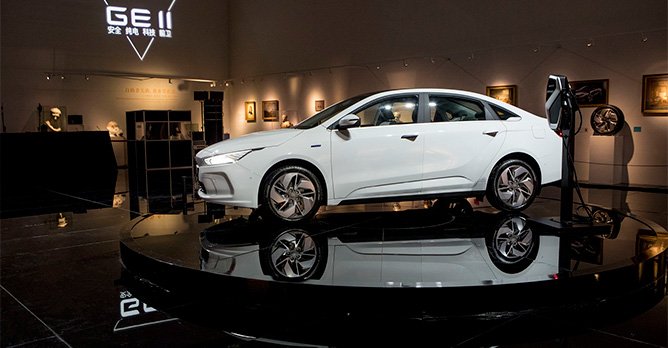
 With its large battery, the long-range A easily eclipsed 400km on a single charge - still impressive today And although the Geometry A was anything but high performance, its figures were perfectly decent for a mid-range EV. A single motor produced 158bhp and 250Nm of torque, good for an 8.8-second century sprint.
With its large battery, the long-range A easily eclipsed 400km on a single charge - still impressive today And although the Geometry A was anything but high performance, its figures were perfectly decent for a mid-range EV. A single motor produced 158bhp and 250Nm of torque, good for an 8.8-second century sprint.
But where the Geometry A excelled, as we've seen from other Chinese EVs, was in its range and spectrum of features. Off a 51.9kWh battery pack, the standard-range variant was already clocking 410km on the NEDC-cycle. With capacity upped to 61.9kWh, the long-range variant was then able to do 500km. These are numbers that still hold up now - three years after the car was launched.
While highly-raved cars like the Ford F150 Lightning have just recently impressed audiences with their ability to becoming literal roving powerplants, the Geometry A also already had that trick in its bag back in the day with its Super E Energy Station system.
Finally, by offering a generous range of Level 2-classified safety systems as standard, Geometry made clear that it was positioning the A (and its entire brand) as a more upmarket product.
It comes as no surprise, then, that at least one large player in the local car industry was closely watching.
News broke shortly after the car's launch that the Chinese marque had already signed a Memorandum of Understanding with Hong Seh Motors (known widely as the previous exclusive dealer of the Ferrari and Maserati brands) for distributorship of the cars within Southeast Asia and Australasia. For a while, a few units even made it to Hong Seh's showroom for a brief stint.
Among the 18,000 overseas pre-orders that Geometry claimed for the electric sedan at launch, Singapore was highlighted as one of the key markets. At the time, we even speculated that the car would likely go on sale at the next Singapore Motorshow, come early 2020.
Then, February 2020 actually hit.
Delays are almost unquestioned at this point in the post-pandemic era. Disappearances, however, are different altogether. It's worth noting that the April 2019 event was no typical local car launch; Marina Bay Sands actually marked the site of the Geometry A's global premiere. That only makes the complete erasure of the math-inspired nameplate from the consciousness of our local auto industry more glaring.
The obvious question now is: What happened?
Even now, exactly why the Geometry A vanished without a single word or trace is unclear (we tried reaching out to Hong Seh for a comment, and didn't receive a response). But it's almost a foregone conclusion that the pandemic halted Geometry's international rollout entirely in its tracks.
Admittedly, writing about the car thus far in past tense has been misleading.
Geometry has been pushing cars out of its factory in increasing numbers over the past year and a half, and an update - called the Geometry A Pro - was even released last year boasting a range of up to 600km. Which is to say, the model certainly doesn't belong to the category of 'vaporware EVs'.
Yet it would appear that few - if none - of the 18,000 overseas pre-orders Geometry claimed for the car have been fulfilled.
Take a quick look around YouTube and you'll struggle to find video reviews of the car apart from a couple of China-based channels (a good counter-image to this is BYD's Atto 3).
It's likely Hong Seh got the shorter end of the stick in this partnership; all of the units that had reached our shores during the initial launch were display-only units, with the steering wheel found exclusively on the left-hand side.
I think of the Atto 3 we recently tested and all that it represents as a (successful) landmark model for BYD's presence in overseas markets, and cannot help but imagine that the Geometry A bore similar promise.
It may well be that the brand is already planning a return in the future. But car markets only have so much space for a few brands to thrive - and this reality holds extra weight in somewhere as small as Singapore.
Among the relative newcomers, Tesla already serves the tech-geeks, Polestar pulls off Scandinavian chic, and BYD will likely maintain its efficient and marathoning-image (while pushing into more whimsical territory). Where does that leave Geometry?
Thwarted once - unfairly - by the pandemic, it's still too soon to write off the potential of the Chinese marque's return. But even if the brand does decide that our right-hand drive market is worth reconsidering, it no longer has the headstart that it could have had, back in early 2020. Till then, the Geometry A also remains forgotten on our shores - and out of our EV equation.
Stay tuned for Part 2. In the meantime, here are some other articles that may interest you:
The German, Japanese and Korean cars are fine, but China-made should not be dismissed
Tesla is cool, but check out these 5 EVs that we aren't getting!
A fixed road tax should apply to all EVs in Singapore
EV ownership costs in Singapore - can you afford an electric car?
The Geometry A was Geely's first attempt at a mass market EV - even holding the honour of debuting the entire Geometry brand itself. And despite its questionable marketing shtick (the arithmetic language still muddies quick searches/search-engine optimisation, and no, 'A' doesn't represent the brand's first model, but 'Archimedes', as in the Greek mathematician), the car itself was anything but 'try-hard'.
Mostly due to the fact that it was an electric-converted version of the combustion-engined Geely Emgrand L (think of it as an i- or EQ-fication), absolutely nothing about its exterior shouted for attention apart from its grille-less front.
The Geometry A was a typical three-box; nondescript, and confidently so. Inside, clean lines and muted colours also brought out a sense of modernity without alienating its inhabitants too overtly.
The car as a package started to sound even better once its specifications - despite that lack of a bespoke platform - were taken into consideration. For one, its highly-touted, ultra-low drag co-efficient of 0.2375cD - said to be "comparable to high-performance models" - was an unmistakable challenge at the time to Tesla's Model 3.

But where the Geometry A excelled, as we've seen from other Chinese EVs, was in its range and spectrum of features. Off a 51.9kWh battery pack, the standard-range variant was already clocking 410km on the NEDC-cycle. With capacity upped to 61.9kWh, the long-range variant was then able to do 500km. These are numbers that still hold up now - three years after the car was launched.
While highly-raved cars like the Ford F150 Lightning have just recently impressed audiences with their ability to becoming literal roving powerplants, the Geometry A also already had that trick in its bag back in the day with its Super E Energy Station system.
Finally, by offering a generous range of Level 2-classified safety systems as standard, Geometry made clear that it was positioning the A (and its entire brand) as a more upmarket product.
It comes as no surprise, then, that at least one large player in the local car industry was closely watching.
News broke shortly after the car's launch that the Chinese marque had already signed a Memorandum of Understanding with Hong Seh Motors (known widely as the previous exclusive dealer of the Ferrari and Maserati brands) for distributorship of the cars within Southeast Asia and Australasia. For a while, a few units even made it to Hong Seh's showroom for a brief stint.
Among the 18,000 overseas pre-orders that Geometry claimed for the electric sedan at launch, Singapore was highlighted as one of the key markets. At the time, we even speculated that the car would likely go on sale at the next Singapore Motorshow, come early 2020.
Then, February 2020 actually hit.
Delays are almost unquestioned at this point in the post-pandemic era. Disappearances, however, are different altogether. It's worth noting that the April 2019 event was no typical local car launch; Marina Bay Sands actually marked the site of the Geometry A's global premiere. That only makes the complete erasure of the math-inspired nameplate from the consciousness of our local auto industry more glaring.
The obvious question now is: What happened?
Even now, exactly why the Geometry A vanished without a single word or trace is unclear (we tried reaching out to Hong Seh for a comment, and didn't receive a response). But it's almost a foregone conclusion that the pandemic halted Geometry's international rollout entirely in its tracks.
Admittedly, writing about the car thus far in past tense has been misleading.
Geometry has been pushing cars out of its factory in increasing numbers over the past year and a half, and an update - called the Geometry A Pro - was even released last year boasting a range of up to 600km. Which is to say, the model certainly doesn't belong to the category of 'vaporware EVs'.
Yet it would appear that few - if none - of the 18,000 overseas pre-orders Geometry claimed for the car have been fulfilled.
Take a quick look around YouTube and you'll struggle to find video reviews of the car apart from a couple of China-based channels (a good counter-image to this is BYD's Atto 3).
It's likely Hong Seh got the shorter end of the stick in this partnership; all of the units that had reached our shores during the initial launch were display-only units, with the steering wheel found exclusively on the left-hand side.
I think of the Atto 3 we recently tested and all that it represents as a (successful) landmark model for BYD's presence in overseas markets, and cannot help but imagine that the Geometry A bore similar promise.
It may well be that the brand is already planning a return in the future. But car markets only have so much space for a few brands to thrive - and this reality holds extra weight in somewhere as small as Singapore.
Among the relative newcomers, Tesla already serves the tech-geeks, Polestar pulls off Scandinavian chic, and BYD will likely maintain its efficient and marathoning-image (while pushing into more whimsical territory). Where does that leave Geometry?
Thwarted once - unfairly - by the pandemic, it's still too soon to write off the potential of the Chinese marque's return. But even if the brand does decide that our right-hand drive market is worth reconsidering, it no longer has the headstart that it could have had, back in early 2020. Till then, the Geometry A also remains forgotten on our shores - and out of our EV equation.
Stay tuned for Part 2. In the meantime, here are some other articles that may interest you:
The German, Japanese and Korean cars are fine, but China-made should not be dismissed
Tesla is cool, but check out these 5 EVs that we aren't getting!
A fixed road tax should apply to all EVs in Singapore
EV ownership costs in Singapore - can you afford an electric car?
A star-studded, shimmering launch at Marina Bay Sands in April 2019. Financial and technological backing by a multi-national Chinese conglomerate, in charge of some very successful automotive brands. And above all, specifications for an electrical vehicle (EV) that would have made an enticing case for a switchover from ICE cars.
The Geometry A was Geely's first attempt at a mass market EV - even holding the honour of debuting the entire Geometry brand itself. And despite its questionable marketing shtick (the arithmetic language still muddies quick searches/search-engine optimisation, and no, 'A' doesn't represent the brand's first model, but 'Archimedes', as in the Greek mathematician), the car itself was anything but 'try-hard'.
Mostly due to the fact that it was an electric-converted version of the combustion-engined Geely Emgrand L (think of it as an i- or EQ-fication), absolutely nothing about its exterior shouted for attention apart from its grille-less front.
The Geometry A was a typical three-box; nondescript, and confidently so. Inside, clean lines and muted colours also brought out a sense of modernity without alienating its inhabitants too overtly.
The car as a package started to sound even better once its specifications - despite that lack of a bespoke platform - were taken into consideration. For one, its highly-touted, ultra-low drag co-efficient of 0.2375cD - said to be "comparable to high-performance models" - was an unmistakable challenge at the time to Tesla's Model 3.

 With its large battery, the long-range A easily eclipsed 400km on a single charge - still impressive today And although the Geometry A was anything but high performance, its figures were perfectly decent for a mid-range EV. A single motor produced 158bhp and 250Nm of torque, good for an 8.8-second century sprint.
With its large battery, the long-range A easily eclipsed 400km on a single charge - still impressive today And although the Geometry A was anything but high performance, its figures were perfectly decent for a mid-range EV. A single motor produced 158bhp and 250Nm of torque, good for an 8.8-second century sprint.
But where the Geometry A excelled, as we've seen from other Chinese EVs, was in its range and spectrum of features. Off a 51.9kWh battery pack, the standard-range variant was already clocking 410km on the NEDC-cycle. With capacity upped to 61.9kWh, the long-range variant was then able to do 500km. These are numbers that still hold up now - three years after the car was launched.
While highly-raved cars like the Ford F150 Lightning have just recently impressed audiences with their ability to becoming literal roving powerplants, the Geometry A also already had that trick in its bag back in the day with its Super E Energy Station system.
Finally, by offering a generous range of Level 2-classified safety systems as standard, Geometry made clear that it was positioning the A (and its entire brand) as a more upmarket product.
It comes as no surprise, then, that at least one large player in the local car industry was closely watching.
News broke shortly after the car's launch that the Chinese marque had already signed a Memorandum of Understanding with Hong Seh Motors (known widely as the previous exclusive dealer of the Ferrari and Maserati brands) for distributorship of the cars within Southeast Asia and Australasia. For a while, a few units even made it to Hong Seh's showroom for a brief stint.
Among the 18,000 overseas pre-orders that Geometry claimed for the electric sedan at launch, Singapore was highlighted as one of the key markets. At the time, we even speculated that the car would likely go on sale at the next Singapore Motorshow, come early 2020.
Then, February 2020 actually hit.
Delays are almost unquestioned at this point in the post-pandemic era. Disappearances, however, are different altogether. It's worth noting that the April 2019 event was no typical local car launch; Marina Bay Sands actually marked the site of the Geometry A's global premiere. That only makes the complete erasure of the math-inspired nameplate from the consciousness of our local auto industry more glaring.
The obvious question now is: What happened?
Even now, exactly why the Geometry A vanished without a single word or trace is unclear (we tried reaching out to Hong Seh for a comment, and didn't receive a response). But it's almost a foregone conclusion that the pandemic halted Geometry's international rollout entirely in its tracks.
Admittedly, writing about the car thus far in past tense has been misleading.
Geometry has been pushing cars out of its factory in increasing numbers over the past year and a half, and an update - called the Geometry A Pro - was even released last year boasting a range of up to 600km. Which is to say, the model certainly doesn't belong to the category of 'vaporware EVs'.
Yet it would appear that few - if none - of the 18,000 overseas pre-orders Geometry claimed for the car have been fulfilled.
Take a quick look around YouTube and you'll struggle to find video reviews of the car apart from a couple of China-based channels (a good counter-image to this is BYD's Atto 3).
It's likely Hong Seh got the shorter end of the stick in this partnership; all of the units that had reached our shores during the initial launch were display-only units, with the steering wheel found exclusively on the left-hand side.
I think of the Atto 3 we recently tested and all that it represents as a (successful) landmark model for BYD's presence in overseas markets, and cannot help but imagine that the Geometry A bore similar promise.
It may well be that the brand is already planning a return in the future. But car markets only have so much space for a few brands to thrive - and this reality holds extra weight in somewhere as small as Singapore.
Among the relative newcomers, Tesla already serves the tech-geeks, Polestar pulls off Scandinavian chic, and BYD will likely maintain its efficient and marathoning-image (while pushing into more whimsical territory). Where does that leave Geometry?
Thwarted once - unfairly - by the pandemic, it's still too soon to write off the potential of the Chinese marque's return. But even if the brand does decide that our right-hand drive market is worth reconsidering, it no longer has the headstart that it could have had, back in early 2020. Till then, the Geometry A also remains forgotten on our shores - and out of our EV equation.
Stay tuned for Part 2. In the meantime, here are some other articles that may interest you:
The German, Japanese and Korean cars are fine, but China-made should not be dismissed
Tesla is cool, but check out these 5 EVs that we aren't getting!
A fixed road tax should apply to all EVs in Singapore
EV ownership costs in Singapore - can you afford an electric car?
The Geometry A was Geely's first attempt at a mass market EV - even holding the honour of debuting the entire Geometry brand itself. And despite its questionable marketing shtick (the arithmetic language still muddies quick searches/search-engine optimisation, and no, 'A' doesn't represent the brand's first model, but 'Archimedes', as in the Greek mathematician), the car itself was anything but 'try-hard'.
Mostly due to the fact that it was an electric-converted version of the combustion-engined Geely Emgrand L (think of it as an i- or EQ-fication), absolutely nothing about its exterior shouted for attention apart from its grille-less front.
The Geometry A was a typical three-box; nondescript, and confidently so. Inside, clean lines and muted colours also brought out a sense of modernity without alienating its inhabitants too overtly.
The car as a package started to sound even better once its specifications - despite that lack of a bespoke platform - were taken into consideration. For one, its highly-touted, ultra-low drag co-efficient of 0.2375cD - said to be "comparable to high-performance models" - was an unmistakable challenge at the time to Tesla's Model 3.

But where the Geometry A excelled, as we've seen from other Chinese EVs, was in its range and spectrum of features. Off a 51.9kWh battery pack, the standard-range variant was already clocking 410km on the NEDC-cycle. With capacity upped to 61.9kWh, the long-range variant was then able to do 500km. These are numbers that still hold up now - three years after the car was launched.
While highly-raved cars like the Ford F150 Lightning have just recently impressed audiences with their ability to becoming literal roving powerplants, the Geometry A also already had that trick in its bag back in the day with its Super E Energy Station system.
Finally, by offering a generous range of Level 2-classified safety systems as standard, Geometry made clear that it was positioning the A (and its entire brand) as a more upmarket product.
It comes as no surprise, then, that at least one large player in the local car industry was closely watching.
News broke shortly after the car's launch that the Chinese marque had already signed a Memorandum of Understanding with Hong Seh Motors (known widely as the previous exclusive dealer of the Ferrari and Maserati brands) for distributorship of the cars within Southeast Asia and Australasia. For a while, a few units even made it to Hong Seh's showroom for a brief stint.
Among the 18,000 overseas pre-orders that Geometry claimed for the electric sedan at launch, Singapore was highlighted as one of the key markets. At the time, we even speculated that the car would likely go on sale at the next Singapore Motorshow, come early 2020.
Then, February 2020 actually hit.
Delays are almost unquestioned at this point in the post-pandemic era. Disappearances, however, are different altogether. It's worth noting that the April 2019 event was no typical local car launch; Marina Bay Sands actually marked the site of the Geometry A's global premiere. That only makes the complete erasure of the math-inspired nameplate from the consciousness of our local auto industry more glaring.
The obvious question now is: What happened?
Even now, exactly why the Geometry A vanished without a single word or trace is unclear (we tried reaching out to Hong Seh for a comment, and didn't receive a response). But it's almost a foregone conclusion that the pandemic halted Geometry's international rollout entirely in its tracks.
Admittedly, writing about the car thus far in past tense has been misleading.
Geometry has been pushing cars out of its factory in increasing numbers over the past year and a half, and an update - called the Geometry A Pro - was even released last year boasting a range of up to 600km. Which is to say, the model certainly doesn't belong to the category of 'vaporware EVs'.
Yet it would appear that few - if none - of the 18,000 overseas pre-orders Geometry claimed for the car have been fulfilled.
Take a quick look around YouTube and you'll struggle to find video reviews of the car apart from a couple of China-based channels (a good counter-image to this is BYD's Atto 3).
It's likely Hong Seh got the shorter end of the stick in this partnership; all of the units that had reached our shores during the initial launch were display-only units, with the steering wheel found exclusively on the left-hand side.
I think of the Atto 3 we recently tested and all that it represents as a (successful) landmark model for BYD's presence in overseas markets, and cannot help but imagine that the Geometry A bore similar promise.
It may well be that the brand is already planning a return in the future. But car markets only have so much space for a few brands to thrive - and this reality holds extra weight in somewhere as small as Singapore.
Among the relative newcomers, Tesla already serves the tech-geeks, Polestar pulls off Scandinavian chic, and BYD will likely maintain its efficient and marathoning-image (while pushing into more whimsical territory). Where does that leave Geometry?
Thwarted once - unfairly - by the pandemic, it's still too soon to write off the potential of the Chinese marque's return. But even if the brand does decide that our right-hand drive market is worth reconsidering, it no longer has the headstart that it could have had, back in early 2020. Till then, the Geometry A also remains forgotten on our shores - and out of our EV equation.
Stay tuned for Part 2. In the meantime, here are some other articles that may interest you:
The German, Japanese and Korean cars are fine, but China-made should not be dismissed
Tesla is cool, but check out these 5 EVs that we aren't getting!
A fixed road tax should apply to all EVs in Singapore
EV ownership costs in Singapore - can you afford an electric car?
Thank You For Your Subscription.













